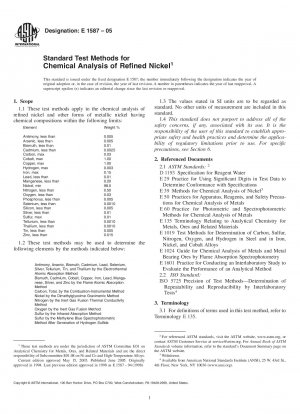ASTM E1587-05
Standard Test Methods for Chemical Analysis of Refined Nickel
- Standard No.
- ASTM E1587-05
- Release Date
- 2005
- Published By
- American Society for Testing and Materials (ASTM)
- Status
- Replace By
- ASTM E1587-10
- Latest
- ASTM E1587-17
- Scope
These test methods are primarily intended to test refined nickel metal for compliance with compositional specifications. It is assumed that all who use these test methods will be trained analysts capable of performing common laboratory procedures skillfully and safely. It is expected that the analytical work will be performed in a properly equipped laboratory under appropriate quality control practices.
1.1 These test methods apply to the chemical analysis of refined nickel and other forms of metallic nickel having chemical compositions within the following limits:
Element Weight % Antimony, less than 0.005 Arsenic, less than 0.005 Bismuth, less than 0.01 Cadmium, less than 0.0025 Carbon, max 0.03 Cobalt, max 1.00 Copper, max 1.00 Hydrogen, max 0.003 Iron, max 0.15 Lead, less than 0.01 Manganese, less than 0.20 Nickel, min 98.0 Nitrogen, less than 0.50 Oxygen, less than 0.03 Phosphorus, less than 0.005 Selenium, less than 0.0010 Silicon, less than 0.005 Silver, less than 0.01 Sulfur, max 0.01 Tellurium, less than 0.0010 Thallium, less than 0.0010 Tin, less than 0.005 Zinc, less than 0.015 1.2 These test methods may be used to determine the following elements by the methods indicated below:
Antimony, Arsenic, Bismuth, Cadmium, Lead, Selenium, Silver, Tellurium, Tin, and Thallium by the Electrothermal Atomic Absorption Method Bismuth, Cadmium, Cobalt, Copper, Iron, Lead, Manganese, Silver, and Zinc by the Flame Atomic Absorption Method Carbon, Total, by the Combustion-Instrumental Method Nickel by the Dimethylglyoxime Gravimetric Method Nitrogen by the Inert Gas Fusion Thermal Conductivity Method Oxygen by the Inert Gas Fusion Method Sulfur by the Infrared Absorption Method Sulfur by the Methylene Blue Spectrophotometric Method After Generation of Hydrogen Sulfide 1.3 The values stated in SI units are to be regarded as standard. No other units of measurement are included in this standard.
1.4 This standard does not purport to address all of the safety concerns, if any, associated with its use. It is the responsibility of the user of this standard to establish appropriate safety and health practices and determine the applicability of regulatory limitations prior to use. For specific precautions, see Section 6.
ASTM E1587-05 Referenced Document
- ASTM D1193 Standard Specification for Reagent Water
- ASTM E1019 Standard Test Methods for Determination of Carbon, Sulfur, Nitrogen, and Oxygen in Steel and in Iron, Nickel, and Cobalt Alloys*, 2024-04-19 Update
- ASTM E1024 Standard Guide for Chemical Analysis of Metals and Metal Bearing Ores by Flame Atomic Absorption Spectrophotometry (Withdrawn 2004)
- ASTM E135 Standard Terminology Relating to Analytical Chemistry for Metals, Ores, and Related Materials
- ASTM E1601 Standard Practice for Conducting an Interlaboratory Study to Evaluate the Performance of an Analytical Method
- ASTM E29 Standard Practice for Using Significant Digits in Test Data to Determine Conformance with Specifications
- ASTM E39 Methods for Chemical Analysis of Nickel
- ASTM E50 Standard Practice for Apparatus, Reagents, and safety Precautions for Chemical Analysis of Metals
- ASTM E60 Standard Practice for Analysis of Metals, Ores, and Related Materials by Molecular Absorption Spectrometry
- ISO 5725 Precision of test methods; Determination of repeatability and reproducibility for a standard test method by inter-laboratory tests
ASTM E1587-05 history
- 2017 ASTM E1587-17 Standard Test Methods for Chemical Analysis of Refined Nickel
- 2010 ASTM E1587-10 Standard Test Methods for Chemical Analysis of Refined Nickel
- 2005 ASTM E1587-05 Standard Test Methods for Chemical Analysis of Refined Nickel
- 1998 ASTM E1587-94(1998) Standard Test Methods for Chemical Analysis of Refined Nickel
